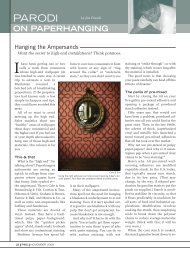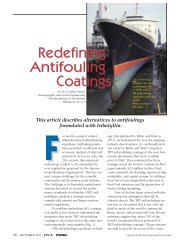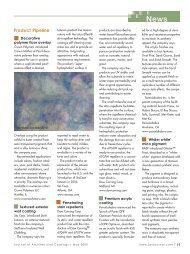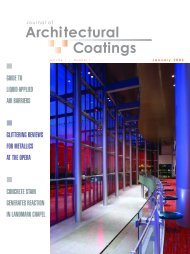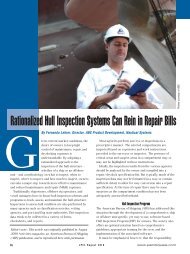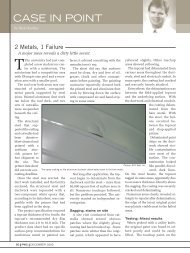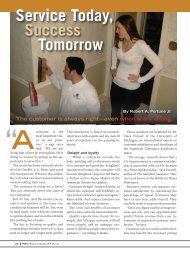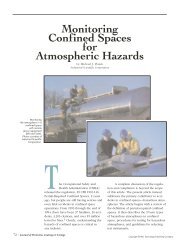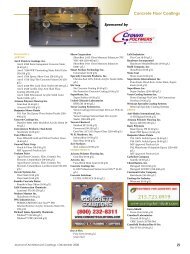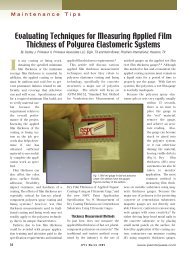Decorative Treatments for Concrete Floors: A ... - PaintSquare
Decorative Treatments for Concrete Floors: A ... - PaintSquare
Decorative Treatments for Concrete Floors: A ... - PaintSquare
Create successful ePaper yourself
Turn your PDF publications into a flip-book with our unique Google optimized e-Paper software.
21as this will thin the densifier material as it gels to help facilitate deeper penetration and simplifythe job of removing excess product.The environmental profile of the densifier product also plays a primary role in the“green” credentials of the specific concrete-polishing process. This profile is determinedby VOC content, the nature of the waste material generated, and disposal parameters.The entire densification process takes approximately 30 to 45 minutes. The surface isthen allowed to dry <strong>for</strong> 24 hours be<strong>for</strong>e the resin-bond diamond segments are used to polishto the desired level. The process produces a hard, dense, and sealed surface.Adding colorIf coloring of the concrete is part of the picture, numerous options are available, includingintegral coloring of the concrete, staining, and dyeing.With integral coloring, an admixture is incorporated in the concrete mix to produce uni<strong>for</strong>mcolor throughout the slab. With a dye or stain, the concrete surface is colored be<strong>for</strong>eapplying the densifier, allowing unlimited color combinations and edge-tint options. Dyesor stains are typically applied after polishing at the 400-grit level. A second coat may beadded later in the process or at the end to increase the effect or intensity of the color. Careshould be taken to wash the surface of dyed or stained sections with water, followed bycomplete drying be<strong>for</strong>e the next polishing phase begins.Levels of shineAttaining the desired level of shine depends on the number of passes of the diamond discgrinder, as each step increasingly flattens the floor and enhances light reflectivity. Polishingsystems that require minimal process steps—less than five—do not constitute a truegrinding and polishing system, which involves a five- to ten-step process, including thehardening and densification application.These less-complete (and lower-cost) types of systems are commonly referred to as topical,as their penetration of the surface is limited, leading to early wear and loss of gloss andreflectivity.The safety issue: Polishing and slipContrary to a common perception, the degree of polish or shine is not directly related to slipresistance. A 400-grit finish can and usually is less slip-resistant than a 1500- or 3000-gritfinal finish.It helps to think of it in this way: when a floor is wet and a person walks on it, the peaksand valleys in the landscape of the surface create a tendency <strong>for</strong> the person to “hydroplane.”On a completely flat surface such as that produced by 1500 or 3000 grit, thewater is pressed out from under the shoe, putting the sole directly in contact with the concretesurface—actually making the shoe stick to the surface.A true grinding and polishing system with the highest levels of shine (using 3000-grit polishing)and gloss (gloss meter readings in the range of 45 to 65) exceeds OSHA (OccupationalSafety and Health Administration) and Americans with Disabilities Act (ADA)standards <strong>for</strong> coefficient of friction and slip resistance, which are the two most widely acceptedstandards <strong>for</strong> these safety criteria. The process creates an attractive environmentwith increased light reflectivity, a desirable characteristic in today’s safety-conscious marketplace.Standard coefficient of friction (COF) numbers <strong>for</strong> an 800-grit or semigloss polished-concretesurface will range from .79 to .84, a 1500-grit or gloss finish will yield a COF of .84 to



